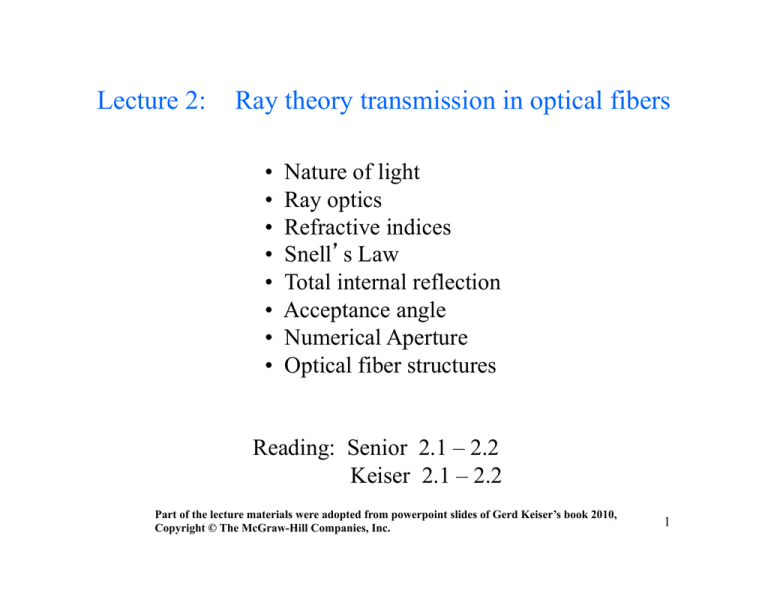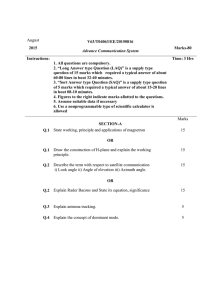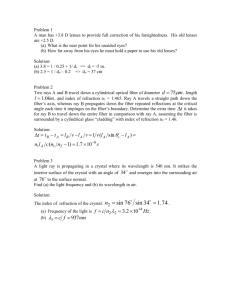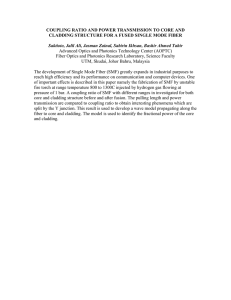Optical Fiber Ray Theory: Transmission & Principles
advertisement

Lecture 2: Ray theory transmission in optical fibers • • • • • • • • Nature of light Ray optics Refractive indices Snell’s Law Total internal reflection Acceptance angle Numerical Aperture Optical fiber structures Reading: Senior 2.1 – 2.2 Keiser 2.1 – 2.2 Part of the lecture materials were adopted from powerpoint slides of Gerd Keiser’s book 2010, Copyright © The McGraw-Hill Companies, Inc. 1 A Brief Historical Note • Beyond the middle ages: –Newton (1642-1726) and Huygens (1629-1695) fight over nature of light • 18th–19th centuries –Fresnel, Young experimentally observe diffraction, defeat Newton’s particle theory –Maxwell formulates electro-magnetic equations, Hertz verifies antenna emission principle (1899) • 20th century –Quantum theory explains wave-particle duality –Invention of holography (1948) –Invention of laser principle (1954) –1st demonstration of laser (1960) –Proposal of fiber optic communications (1966) –1st demonstration of low-loss optical fibers (1970) –Optical applications proliferate into the 21st century: nonlinear optics, fiber optics, laser-based spectroscopy, computing, communications, fundamental science, medicine, biology, manufacturing, entertainment, … (Let all flowers blossom!) 2 The nature of light 3 Light as waves, rays and photons • Light is an electromagnetic wave. • While light is a wave, it nevertheless travels along straight lines or rays, enabling us to analyze simple optical components (e.g. lenses and mirrors) and instruments in terms of geometrical optics. • Light is also a stream of photons, discrete particles carrying packets of energy and momentum. (We will cover this after mid-term.) 4 Spherical waves and their associated rays • e.g. a point source (like a stone dropped in water) • Light is emitted in all directions as a spherical wave – series of crests and troughs forming spherical wavefronts • Distance between adjacent crests is the wavelength λ Rays – lines perpendicular to wavefronts λ Wavefront Surface of constant phase 5 Plane waves and their associated rays • Spherical waves – wavefronts are spherical (rays are perpendicular to the wavefronts and point radially outwards) • Plane waves – wavefronts are planes (rays are perpendicular to plane wavefronts in the direction of propagation) • Spherical waves from a point source at a far distance from an observer appears as a plane wave Planes parallel to x-y plane Rays are collimated z 6 Ray Optics or Geometrical Optics Wavelength λ << size of the optical component ray λ wavefront • In many applications of interest the wavelength λ of light is short compared with the relevant length scales of the optical components or system (e.g. mirrors, prisms, lenses). • This branch of optics is referred to as Ray optics or Geometrical Optics, where energy of light is propagated along rays. 7 • The rays are perpendicular to the wavefronts. Ray Optics: basic laws ni sin θi = nt sin θt 8 Snell’s Law When a ray is incident on the interface between two dielectrics of different refractive indices (e.g. glass-air), reflection and refraction occur. normal low index n2 (air) high index n1 (glass) θ2 refraction Plane of incidence ≡ plane that comprises the incident ray and the plane normal θ1 θ1 reflection The angle of incidence θ1 and the angle of refraction θ2 are related to each other, and to the refractive indices of the dielectrics by Snell’s law of refraction: n1 sin θ1 = n2 sin θ2 9 Refractive index • In any dielectric medium, the speed of light becomes v = c/n The factor n is the index of refraction (or refractive index) of the medium. e.g. For air and gases, v ~ c, so that n ~ 1. At optic frequencies, the refractive index of water is 1.33. e.g. Glass has many compositions, each with a slightly different n. An approximate refractive index of 1.5 is representative for the silica glasses used in fibers; more precise values for these glasses lie between ~1.45 and ~1.48. 10 Index of refraction for some materials Air Water Magnesium fluoride Fused silica (SiO2) Sapphire (Al2O3) Lithium niobate (LiNbO3) Indium phosphide (InP) Gallium arsenide (GaAs) Silicon (Si) 3.48 Indium gallium arsenide phosphide (InGaAsP) Aluminum gallium arsenide (AlGaAs) Germanium (Ge) 1.0 1.33 1.38 1.46 1.8 2.25 3.21 3.35 3.51 3.6 4.0 *The index varies with a number of parameters, such as wavelength and temperature. 11 Critical angle For n1 > n2, the angle of refraction θ2 is always greater than the angle of incidence θ1. • When the angle of refraction θ2 is 90o, the refracted ray emerges parallel to the interface between the media. This is the limiting case of refraction and the angle of incidence is known as the critical angle θc. low index n2 (air) high index n1 (glass) θ2 θc θc refraction sin θc = n2 / n1 reflection 12 Total internal reflection • At angles of incidence θ > θc, the light is totally reflected back into the incidence higher refractive index medium. This is known as total internal reflection. normal low index n2 (air) high index n1 (glass) θ1 > θc TIR e.g. n1 = 1.44, n2 = 1, then θc = sin-1(1/1.44) = 44o Total internal reflection: θ1 > θc 13 Light ray guiding condition • Light ray that satisfies total internal reflection at the interface of the higher refractive index core and the lower refractive index cladding can be guided along an optical fiber. cladding n2 core n1 θ θ e.g. Under what condition will light be trapped inside the fiber core? n1 = 1.46; n2 = 1.44 θ > θc θc = sin-1 (n2/n1) = sin-1 (1.44/1.46) = 80.5o 14 Optical fiber structures • A typical bare fiber consists of a core, a cladding and a polymer jacket (buffer coating). typically 250 µm including jacket for glass fibers • The polymer coating is the first line of mechanical protection. • The coating also reduces the internal reflection at the cladding, so light is only guided by the core. *In Lab1, we shall learn how to strip off the jacket to expose the cladding. This is necessary in order to “cleave” the fiber for a smooth 15 end face for light coupling. Silica optical fibers • Both the core and the cladding are made from a type of glass known as silica (SiO2) which is almost transparent in the visible and near-IR. • In the case that the refractive index changes in a “step” between the core and the cladding. This fiber structure is known as step-index fiber. • The higher core refractive index (~ 0.3% higher) is typically obtained by doping the silica core with germanium dioxide (GeO2). *In Lab 1, we should be able to see the step boundary between the core and the cladding, by end-illuminating the fiber and imaging the output-end cross-section using a microscope. 16 Numerical aperture • An important characteristic of an optic system is its ability to collect light incident over a wide range of angles. f f θ The numerical aperture (NA) is defined as: NA = no sin θ where no is the refractive index of the medium between the lens and the image plane (e.g. a photodetector) and θ is the maximum acceptance angle. 17 • The definition of numerical aperture applies to all light-collecting systems, including optical fibers. e.g. Light rays incident at angles outside the collection cone for a fiber will not propagate along the fiber (instead will attenuate rapidly). • The numerical aperture is often measured in air, no = 1 NA = sin θ • A low NA indicates a small acceptance angle. ⇒ Light coupling to a low-NA optical system (e.g. fiber) is more difficult (alignment is more sensitive) and less efficient (some of the rays are outside the acceptance angle) than is coupling to a high-NA optical system. 18 Acceptance angle • Only rays with a sufficiently shallow grazing angle (i.e. with an angle to the normal greater than θc) at the core-cladding interface are transmitted by total internal reflection. A θa na n1 n2 αc θc • Ray A incident at the critical angle θc at the core-cladding interface enters the fiber core at an angle θa to the fiber axis, and is refracted at the air-core interface. 19 θ < θa θ > θa θa θa na na n1 n2 αc θc n1 n2 αc θc • Any rays which are incident into the fiber core at an angle > θa have an incident angle less than θc at the core-cladding interface. These rays will NOT be totally internal reflected, thus eventually loss to radiation (at the cladding-jacket interface). 20 • Light rays will be confined inside the fiber core if it is input-coupled at the fiber core end-face within the acceptance angle θa. e.g. What is the fiber acceptance angle when n1 = 1.46 and n2 = 1.44? θc = sin-1 (n2/n1) = 80.5o => αc = 90o - θc = 9.5o using sin θa = n1 sin αc (taking na = 1) θa = sin-1 (n1 sin αc) = sin-1 (1.46 sin 9.5o) ~ 14o => the acceptance angle θa ~ 14o 21 Fiber numerical aperture In fiber optics, we describe the fiber acceptance angle using Numerical Aperture (NA): NA = na sin θa = sin θa = (n12 - n22)1/2 θa na n1 n2 αc θc • We can relate the acceptance angle θa and the refractive indices of the core n1, cladding n2 and air na. 22 • Assuming the end face at the fiber core is flat and normal to the fiber axis (when the fiber has a “nice” cleave), we consider the refraction at the air-core interface using Snell’s law: At θa: na sin θa = n1 sin αc launching the light from air: (na ~ 1) sin θa = n1 sin αc = n1 cos θc = n1 (1 - sin2θc)1/2 = n1 (1 - n22/n12)1/2 = (n12 - n22)1/2 23 • Fiber NA therefore characterizes the fiber’s ability to gather light from a source and guide the light. e.g. What is the fiber numerical aperture when n1 = 1.46 and n2 = 1.44? NA = sin θa = (1.462 - 1.442)1/2 = 0.24 • It is a common practice to define a relative refractive index Δ as: Δ = (n1 - n2) / n1 (n1 ~ n2) => NA = n1 (2Δ)1/2 i.e. Fiber NA only depends on n1 and Δ. 24 Lens coupling to fiber end faces Microscope objective lens collimated laser beam θa few mm focal length θa θa focusing objective lens “fiber under test” collecting objective lens • By measuring the output couple ray cone angle, we can measure the fiber acceptance angle. (This is like part of Lab 1 but without using lenses.) 25 Large-NA fibers? • Developing ways for fiber to collect light efficiently was an important early step in developing practical fiber optic communications (particularly in the 1970s) • It seems logical to have optical fibers with NA as large as possible … with as large Δ as possible … in order to couple maximum amount of light into the fiber. • Soon, we will find out that such large-NA fibers tend to be “multimode” and are unsuitable for high-speed communications because of a limitation known as modal dispersion. • Relatively small-NA fibers are therefore used for high-speed optical communication systems. 26 Typical fiber NA • Silica fibers for long-haul transmission are designed to have numerical apertures from about 0.1 to 0.3. The low NA makes coupling efficiency tend to be poor, but turns out to improve the fiber’s bandwidth! (details later) • Plastic, rather than glass, fibers are available for short-haul communications (e.g. within an automobile). These fibers are restricted to short lengths because of the relatively high attenuation in plastic materials. Plastic optical fibers (POFs) are designed to have high numerical apertures (typically, 0.4 – 0.5) to improve coupling efficiency, and so partially offset the high propagation losses and also enable alignment 27 tolerance. Limitation of ray optics • For smaller fiber diameters that are only few times of the wavelength, geometrical optics approach becomes inadequate. This is because ray optics only describes the direction a plane wave component takes in the fiber, but does not take into account interference among such components. • When interference phenomena are considered it is found that only rays with certain discrete characteristics propagate in the fiber core. • Thus the fiber will only support a discrete number of guided modes. • This becomes critical in small core diameter fibers which only support one (singlemode) or a few modes (multimode). Electromagnetic theory must be applied in this case. 28 Op#cal Fiber Type Comparisons Cladding Cladding 2a 2a Core Core n1 n2 n1 Step-index fiber n1 n2 Graded-index fiber n1 (a) Basic fiber types (b) Sample tailored profiles 29 Numerical Aperture Example 30







